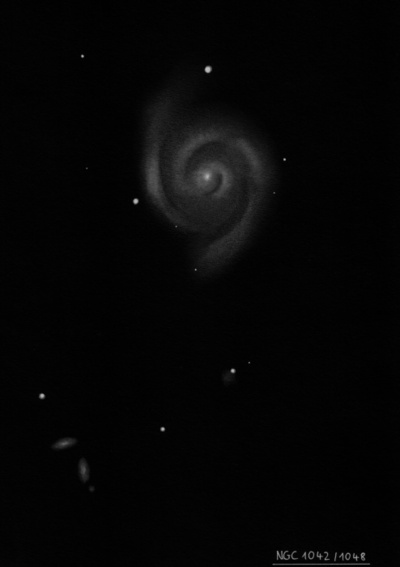
Lewis Swift discovered NGC 1042 = Sw. III-17 on 10 Nov 1885 with the 16" Clark refractor at Warner Observatory and reported "eeF, L, R, np of 2 [with NGC 1052]". In his 5th discovery list, Swift corrected the description to read "sp of 2" [with NGC 1052]. Based on a photograph taken with the Reynolds reflector at the Helwan observatory in the late 1920s, NGC 1042 was described as an "open spiral with a pF stellar Ncl, well defined [arms] with some [knots]."
300/350mm - 13.1" (9/3/86): very large but diffuse, only a very weak concentration.
13.1" (9/9/83): large, very diffuse, no central brightening, irregularly round, best at 62x (too large and diffuse for higher power).
400/500mm - 17.5" (11/1/86): very large, very diffuse low surface brightness system best viewed at 83x or 133x. Almost round, slightly brighter on the SE end with either a very faint star(s) superimposed or a brighter knot. Forms a pair with NGC 1048 (double system) 6' SSE and NGC 1052 lies 14' NE.
900/1200mm - 48" (10/26/16): at 488x; bright, very large, face-on spiral with a small bright core and a relatively small weak bar oriented ~NW-SE. Low contrast spiral structure was visible around the core. Most prominent, though, was an outer spiral arm along the east side, which swept N-S in a gentle arc. It was brightest just to the west of a mag 13.6 star [SDSS reveals numerous HII knots] situated 1.6' SE of the core. The outer spiral arm along the western edge was more diffuse and ill-defined, passing just east of a 16th magnitude star 1.7' WSW of the core.
Notes by Steve Gottlieb